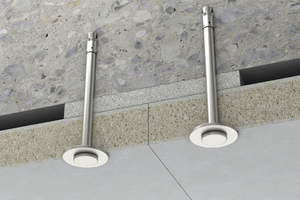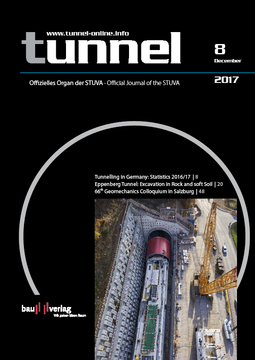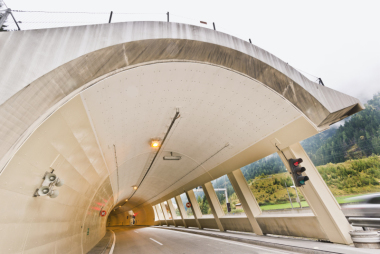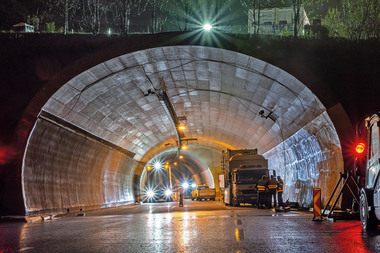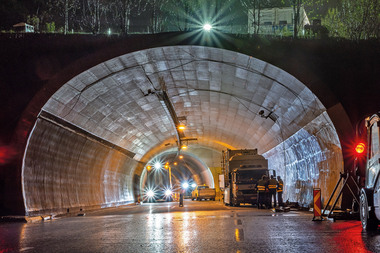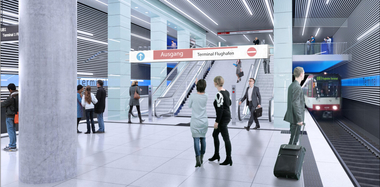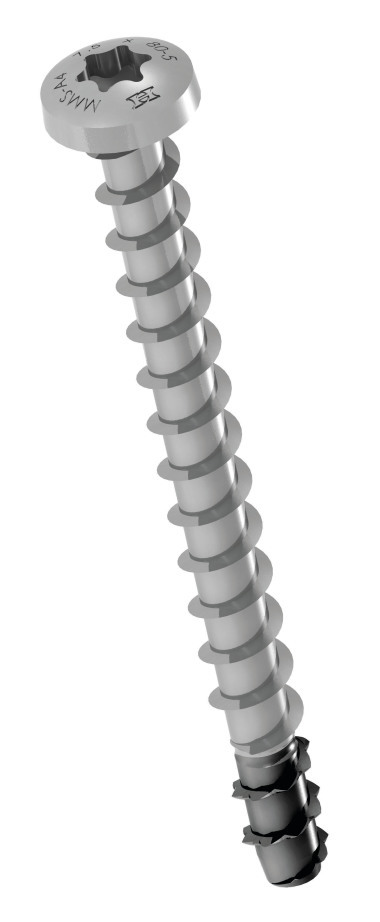Cement-based, glass fibre-reinforced
Tunnel Fire Protection Boards
In order to ensure the highest degree of safety in underground transport facilities, integrated technical solutions in combination with constructional fire protection can be of assistance. Solutions with cement-based fire protection boards with small system thicknesses and weights are becoming increasingly accepted on the market.
The EU tunnel directive of 2004 regulates the minimum requirements for safety in European tunnels and made the legal regulations for tunnel safety considerably more stringent. Since then, these tunnels have been subject to strict requirements and extensive quality testing. In addition to prevention, protection of people is important, with tunnel-specific surveillance, safety and operations systems. Also to be considered are constructional precautions intended to ensure that a fire does not cause any permanent deformations of the structure, which limit the serviceability of the tunnel, or even structural damage, which endangers the structural safety. In addition, the water tightness of the construction should be largely guaranteed.
Requirements for constructional Fire Protection in Tunnels
The requirements for constructional fire protection in tunnels are defined nationally and for each project depending on the size and infrastructure significance. The objective is to provide the appropriate protection measures in the tunnel construction to protect it against excessive temperatures in case of fire and to limit the maximum temperature, both on the concrete surface and at the steel reinforcement. In this way, explosive spalling of the concrete as a result of excess water vapour pressure (see box) should be prevented and the structural safety of the concrete structure should be guaranteed – this includes the limitation of deformation by limiting the reinforcement temperature.
The requirements for the tunnel construction, for example the thickness of fire protection cladding, have been developed on the basis of time-temperature curves. For road tunnels in Germany, this includes the ZTV-Ing curve, according to which it has to be ensured that the loadbearing reinforcement of the tunnel construction does not heat up to a temperature of over 300 °C, and that only construction materials of class A according to DIN 4102 or equivalent are used. Additionally, no substances may be released in the event of a fire that can harm the structure or people. Especially for major international projects, the HCM or RWS curves are often used, which reach a maximum temperature of 1300 °C and 1350 °C respectively. Further requirements for tunnel fire protection still are posed according to the CETU guideline in France, which is based on a combination of various time-temperatures curves and differentiates between the categories N0 (no requirement), N1 (HCM 60 and ISO 120 minutes), N2 (HCM 120 minutes) and N3 (HCM 120 minutes and ISO 240 minutes).
High-Performance Fire Protection Systems
Various methods are available in order to ensure constructional fire protection in tunnels. The use of concretes with PP fibre cement (polypropylene fibres) results in considerably less spalling under the effect of fire than with normal concretes since the plastic fibres melt at high temperatures and the water vapour from the concrete can be relieved through the fine branching of melting PP fibres. This is however associated with a considerable loss of strength in the concrete layers toward the fire, so that it is normally necessary to expensively repair the concrete after a fire incident, for example by spraying render. Since parts of the steel reinforcement have also often suffered, this also has to be replaced.
The requirements of the ZTV-Ing and the RWS curves can also be fulfilled with sprayed render systems, if these are improved with PP fibre cement. The use of this material however takes a lot of time and is very dirty, since the application has to be in two to three layers and hardening times have to be taken into account. The completed surface is rough and needs surface treatment or the application of a fine (sprayed) render. No other works can be carried out simultaneously with the fire protection cladding. The tunnel has to be completely closed, leading to considerable stress for the surrounding transport infrastructure.
Considering all this, fire protection boards, which simply have to be mounted on the existing tunnel wall, are becoming ever more successful on the market. The German manufacturer Fermacell for example offers two products, the tunnel fire protection boards Aestuver T and Aestuver Tx, which have been designed for the highest safety requirements in underground transport facilities. While the fire protection board Aestuver T for concrete-bonded tunnel cladding is mostly used on new cut-and-cover construction projects, the new development Aestuver Tx has been specially developed for subsequently mounted tunnel cladding in new construction as well as in existing tunnels. The cement-based, glass fibre-reinforced lightweight concrete boards in construction material class A1 according to DIN EN 13501-1 combine resistance to frost, de-icing salt and water with high loadbearing capacity, and are easy to work with. The uniformly flat surface of the boards offers a good substrate for painting or coating and makes cleaning simple. If required, all usual cleaning processes with water or steam jetting can be used, even using cleaning agents. A great advantage is that the boards enable checking and inspection of the concrete construction of the tunnel and the joints without damage, because they can be simply removed and mounted again later. The composition of the boards without flammable contents also prevents the release of toxic or visibility-reducing gases in case of fire.
With thicknesses of 10, 15, 20, 25, 30, 35, 40, 50 and 60 mm, the board Aestuver T (ETA-15/0531) has been tested regarding tunnel fires according to international time-temperature curves for concrete-bonded constructions (ZT V/EBA, RWS120, RWS180, HC180, HCM120, HCM180).
With considerably thinner thicknesses (20, 25, 30 und 35 mm) and the resulting low weight of the system, which is about 20 % less than those of comparable products, the Aestuver Tx fire protection board (building material class according to EN 13501-1) fulfils still higher requirements and has proved its performance (RWS 180, RWS 120, HCM120, for the protection level N1/N2/N3, also ISO 240) in numerous international tests (including above all the very stringent French fire protection tests with 60 % of the maximum calculated load resistance of the concrete sample and correspondingly large deformations of about 1/25 of the length of the concrete board).
The boards are mounted as direct planking or on a sub-construction. The thin boards with a format of 2600 x 625 mm enable slender system. This means that shorter fixings can be used, which minimises the chance of meeting the reinforcement. This simplifies mounting, reduces the construction time and thus ensures economical construction. The fixings used are appropriately approved concrete screws or nailed anchors, with or without backing strips as required. One important advantage is that the works can be carried out while traffic continues. As has been shown during the refurbishment of the Bergisel Tunnels on the Brenner autobahn, the traffic can continue to run on a single lane past the construction site. This greatly relieves the infrastructure of the surrounding region and avoids any loss of income for the tunnel operator.
Rita Jacobs, specialist journalist, Düsseldorf, Germany
Spalling behaviour of concrete in case of fire
When a fire occurs, it causes mechanical loading and chemical changes inside the structural concrete, leading to a reduction of mechanical properties such as strength and E modulus. The concrete heats up from the outer zones inward accompanied by dewatering and evaporation processes. This creates a vapour pressure, which can lead to explosive spalling. The tendency to spalling increases with the strength of the structural concrete since the pore content of stronger concretes is less and the permeability is thus less as well. Above all high-strength concretes have been shown to be particularly susceptible to spalling. In addition, smoke gases can penetrate into the concrete through fine cracks, which occur as a result of fire exposure, and can for example accelerate the carbonisation or insert chloride and attack the reinforcing steel.

